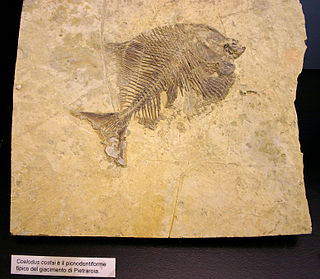| Holderness Formation | |
|---|---|
| Type | Formation |
| Location | |
| Region | England |
| Country | United Kingdom |
The Holderness Formation is a geologic formation in England. It preserves fossils.

Weald Clay or the Weald Clay Formation is a Lower Cretaceous sedimentary rock unit underlying areas of South East England, between the North and South Downs, in an area called the Weald Basin. It is the uppermost unit of the Wealden Group of rocks within the Weald Basin, and the upper portion of the unit is equivalent in age to the exposed portion of the Wessex Formation on the Isle of Wight. It predominantly consists of thinly bedded mudstone. The un-weathered form is blue/grey, and the yellow/orange is the weathered form, it is used in brickmaking.

Coelodus is an extinct genus of fish in the family Pycnodontidae from the Late Jurassic to early Paleocene (Danian). Fossils of the genus have been found in:

Xiphiorhynchus is an extinct genus of prehistoric swordfish that lived from the Eocene until the Miocene. Unlike the modern swordfish, both the upper and lower jaws of Xiphiorhynchus were extended into blade-like points.
The Whiteaves Formation is a geologic formation in British Columbia. It preserves fossils dating back to the Jurassic period.
The Scremerston Formation is a geologic formation in England. It preserves fossils dating back to the Carboniferous period.

The Spilsby Sandstone is a geologic formation in England. It preserves fossils dating back to the Cretaceous period.
The Durlston Formation is a geologic formation in England. Particularly in the Isle of Purbeck. It preserves fossils dating back to the Berriasian stage of the Lower Cretaceous.
The Carstone Formation is a geologic formation in England. It preserves fossils dating back to the Albian stage of the Cretaceous period. It predominantly consists of "greenish-brown, thick-bedded, cross-bedded, oolitic ferruginous sandstone".
The Rutland Formation is a geologic formation in England. It preserves fossils dating back to the late Bajocian to Bathonian stages in the Jurassic period, about 169 million years ago. It is the lateral equivalent of the Sharp's Hill Formation and the Fuller's Earth Formation. The "Rutland Dinosaur" specimen of Cetiosaurus is known from the formation.
The Fullers Earth Formation is a geological formation that outcrops in southern England. It is also mostly present in the subsurface of the Wessex Basin and offshore in the English Channel Basin, Celtic Sea Basin and St George's Channel Basin. It preserves fossils dating back to the Bathonian stage of the Middle Jurassic series such as the pterosaur Dolicorhamphus. It is the lateral equivalent of the Rutland Formation and the Sharp's Hill Formation
The Llanfallteg Formation is a geologic formation in Wales. It preserves fossils dating back to the Ordovician period. It predominantly consists of ash containing siltstones, as wells as ash fall deposits and tuffs. It likely dates to the Darriwilian based on graptolites. The local graptolite fauna includes Didymograptus artus and Glossograptus armatus. The local trilobite fauna includes agnostids, phacopids and asaphids.
The Wittering Formation is a geologic formation in England. It preserves fossils dating back to the Paleogene period.
The Headon Hill Formation is a geological formation found in the Isle of Wight and south Hampshire, England. It preserves fossils dating back to the Priabonian stage.

The Woolwich Formation is a geological formation in southeast England. It preserves fossils dating back to the Paleogene period.
The Downton Castle Sandstone is a geologic formation in England. It preserves fossils dating back to the Silurian period. As its name would suggest the formation predominantly consists of sandstone with minor siltstone and mudstone. The oldest known Trigonotarbid Palaeotarbus is known from the formation.

The Solent Group is a geological group in the Hampshire Basin of southern England. It preserves fossils ranging in age from Priabonian to Rupelian. The group is subdivided into three formations, the Headon Hill Formation, the Bembridge Limestone Formation and the Bouldnor Formation.
The Selborne Group is a geologic group in England. It preserves fossils dating back to the Cretaceous period. It comprises the Gault Formation and the overlying Upper Greensand Formation.

The Ballagan Formation is a geologic formation in Scotland and England. It preserves fossils dating back to the early part of the Carboniferous period (Tournaisian–Visean). Its name comes from Ballagan Glen, near Strathblane, which has a good example of this geological formation.

Pleurosternidae is an extinct family of freshwater turtles belonging to Paracryptodira. They are definitively known from the Late Jurassic to Early Cretaceous (Albian) of Western Europe and North America.